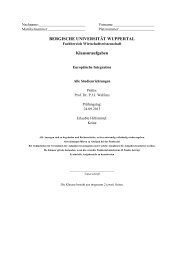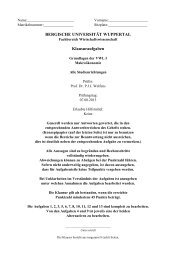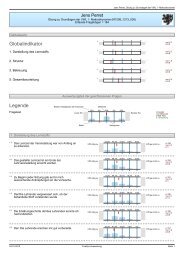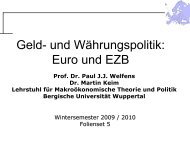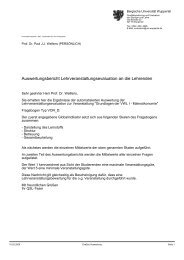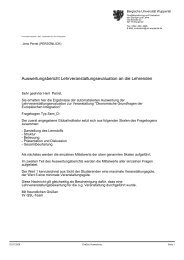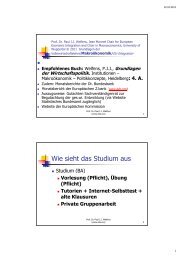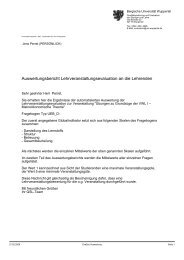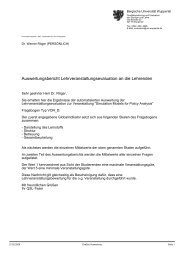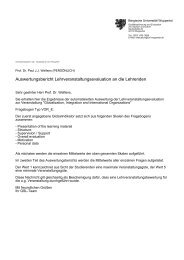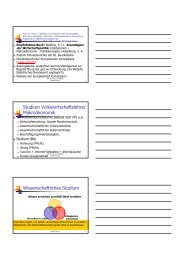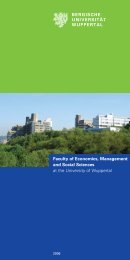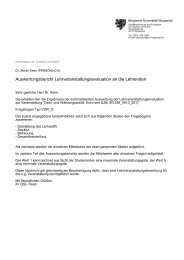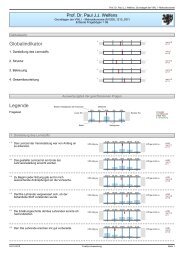UNIVERSITÄT POTSDAM - Prof. Dr. Paul JJ Welfens
UNIVERSITÄT POTSDAM - Prof. Dr. Paul JJ Welfens
UNIVERSITÄT POTSDAM - Prof. Dr. Paul JJ Welfens
You also want an ePaper? Increase the reach of your titles
YUMPU automatically turns print PDFs into web optimized ePapers that Google loves.
38<br />
2<br />
R adj.<br />
0.9970 0.9967 0.9969 0.9966<br />
DW-test 2.0108 2.1136 -- --<br />
EG-test (28.6) b) (28.5) -- --<br />
-5.3968 -5.6735 -- --<br />
(0.0859) c) (0.0261) -- --<br />
F-test of the 1.4396<br />
restriction (0.2345) c)<br />
a)<br />
Empirical t-values are in brackets, but statistical conclusions on the basis of usual t-tests are only<br />
permitted if the third step of the Engle/Yoo procedure has been applied.<br />
b)<br />
Number of observations available after forming lags and first differences and number of I(0) variables<br />
in brackets.<br />
c)<br />
Significance levels in brackets.<br />
The estimation results for the unrestricted and restricted version of this long-term production<br />
function are reported in Table 8. A view of the t-values calculated for the estimates<br />
of the third step of the Engle / Yoo procedure shows that all coefficients of the<br />
unrestricted as well as the restricted estimation are unequal to zero at a significance<br />
level of 1 %. Therefore, all three indicator variables have a highly significant power of<br />
explanation. Furthermore, the magnitudes of their coefficients verify that the factors<br />
approximated by the indicator variables make contributions to real gross value-added<br />
that cannot be neglected. The estimates of the coefficients of the factors capital and<br />
labor also seem to be very reliable. They are rather similar to the estimates in<br />
SCHRÖER / STAHLECKER (1996) where a long-term Cobb-Douglas production<br />
function is estimated using quarterly data from 1970 until 1989. SCHRÖER /<br />
STAHLECKER (1996) introduced after a data mining process a dummy variable which<br />
changes the slope of the time trend to approximate a change of technical progress. The<br />
R 2 s of 0.9977 and 0.9974 for the first step of the Engle / Granger procedure and<br />
0.9976 and 0.9966 for the third step of the Engle / Yoo procedure indicate a very good<br />
fitting of the models to the observed data. The DW test statistics suggest that the presence<br />
of first order autocorrelation can be excluded. Turning to the EG test statistics it<br />
can be seen that the unrestricted as well as the restricted production function forms a<br />
cointegration relation at significance levels of 8.59 % and 2.61 %. Therefore the sum of<br />
the partial production elasticities is now permitted beyond all usual significance levels<br />
as the F-test shows. Based on these estimation and testing results, the restricted product<br />
function containing all three indicator variables is superior to other augmented production<br />
functions with only one or two indicator variables which had been considered during<br />
the empirical investigation, but are not reported here due to the limitation of space.



